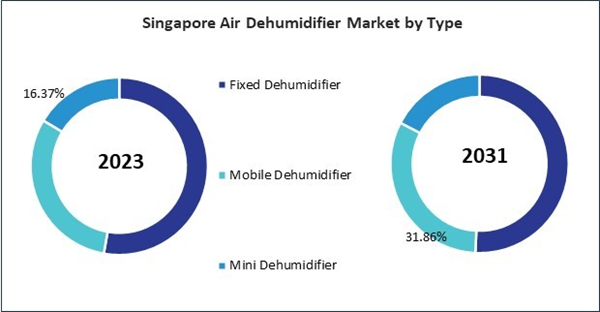In the market, large-capacity units cater to the needs of spaces with significant moisture issues or expansive areas such as warehouses, industrial facilities, large basements, or commercial buildings. These dehumidifiers are engineered to handle high humidity levels efficiently and effectively, offering superior moisture removal capabilities compared to smaller-capacity units. Thus, the India market utilized 32.16 thousand units of large-capacity units in 2023.
The China market dominated the Asia Pacific Air Dehumidifier Market by Country in 2023, and would continue to be a dominant market till 2031; thereby, achieving a market value of $284.7 million by 2031. The Japan market is registering a CAGR of 6.2% during (2024 - 2031). Additionally, The India market would showcase a CAGR of 7.5% during (2024 - 2031).
E-commerce platforms offer various delivery options, including home delivery, express shipping, and click-and-collect services, to accommodate consumer preferences and schedules. Fast and reliable delivery services ensure prompt receipt of air dehumidifiers, enhancing the overall shopping experience for consumers. E-commerce allows manufacturers to bypass traditional distribution channels and sell these products directly to consumers, reducing costs associated with intermediaries and increasing profit margins.
There’s a growing demand for energy-efficient dehumidifiers as consumers seek to reduce energy consumption and lower utility costs. Manufacturers are developing models with improved energy efficiency ratings and eco-friendly refrigerants to meet stringent energy standards and environmental regulations. Compact and portable dehumidifiers are gaining popularity, particularly in small apartments, dormitories, and RVs with limited space.
Rapid population growth and rural-to-urban migration in many countries across the Asia Pacific have developed densely populated urban centers. As urbanization intensifies, the demand for air dehumidifiers increases to address moisture-related issues in residential, commercial, and industrial buildings, where population density and activity levels are high in Asia Pacific. Therefore, due to the above-mentioned factors, the market will grow significantly in this region.
Based on Sales Channel, the market is segmented into Offline and Online. Based on Capacity, the market is segmented into Large Capacity, Medium Capacity and Small Capacity. Based on Type, the market is segmented into Fixed Dehumidifier, Mobile Dehumidifier and Mini Dehumidifier. Based on Price Range, the market is segmented into High Range, Mid-Range, and Low Range. Based on Application, the market is segmented into Industrial, Commercial and Residential. Based on countries, the market is segmented into China, Japan, India, South Korea, Singapore, Malaysia, and Rest of Asia Pacific.
List of Key Companies Profiled
- Sharp Corporation
- AB Electrolux
- Whirlpool Corporation
- De’Longhi Group
- LG Electronics, Inc. (LG Corporation)
- Honeywell International, Inc.
- Haier Smart Home Co., Ltd. (Haier Group Corporation)
- Munters Group AB
- Condair Group AG
- Midea Group Co., Ltd.
Market Report Segmentation
By Sales Channel (Volume, Thousand Units, USD Billion, 2020-2031)- Offline
- Online
- Large Capacity
- Medium Capacity
- Small Capacity
- Fixed Dehumidifier
- Mobile Dehumidifier
- Mini Dehumidifier
- High Range
- Mid Range
- Low Range
- Industrial
- Commercial
- Residential
- China
- Japan
- India
- South Korea
- Singapore
- Malaysia
- Rest of Asia Pacific
Table of Contents
Companies Mentioned
- Sharp Corporation
- AB Electrolux
- Whirlpool Corporation
- De’Longhi Group
- LG Electronics, Inc. (LG Corporation)
- Honeywell International, Inc.
- Haier Smart Home Co., Ltd. (Haier Group Corporation)
- Munters Group AB
- Condair Group AG
- Midea Group Co., Ltd.
Methodology

LOADING...









